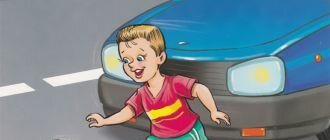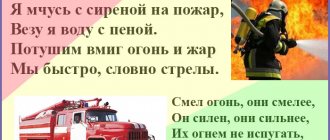Questions with answers on traffic rules for preschoolers
1 question:
Why should you cross the street only at intersections and on pedestrian paths?
Answer:
The driver knows that according to the rules pedestrians are allowed in these places, he drives carefully and reduces speed. A pedestrian who is not where he should be and can get hurt himself and interferes with the driver.
2.Question:
Why can't you cross the street when the traffic light is red or yellow?
Answer:
When the “red” light is on for pedestrians, the “green” light is on for drivers. Seeing a green light, the driver drives quickly and does not expect pedestrians. The red light is on for only a few seconds. Even if there are no cars, you have to resist the urge to cross and wait for the green light.
3.Question:
Why is it dangerous to cross the street?
Answer:
When a child runs, it is difficult for him to observe and see. Everything jumps and it takes a lot of energy. And when crossing the street, the main thing is to carefully watch both left and right, because often the street is deceptive: it seems safe, and suddenly a car drives out from an alley or from behind another car. Motorcycles are even harder to spot.
4.Question:
Why are bushes and trees on the streets dangerous?
Answer:
The danger of bushes and trees is that they also interfere with long-distance views of the street. A pedestrian looks through the bushes - there seems to be nothing. And a car might pass behind them1
5.Question:
Why can't you walk along the roadway?
Answer:
Even walking along the edge of the roadway is dangerous—you might get hit by a car. You only need to walk on the sidewalk.
6.Question:
How to walk on a road that has no sidewalk?
Answer:
When there is no sidewalk (outside a city or town or village), you need to walk along the side of the road facing the traffic, i.e. towards moving traffic - on the left side of the road in order to see those cars that are traveling towards you.
7.Question:
Is it dangerous for a child to see a friend or relatives on the other side of the street?
Answer:
Seeing friends or relatives, the child will be happy and want to quickly meet them across the street. At this time, he may not notice the cars driving down the street.
8.Question:
Why is it dangerous to cross the street together, arm in arm, or hold hands?
Answer:
When a whole column of children crosses the street, it is safe to hold hands. When two or three are crossing, there is no need to hold hands, and especially not arm in arm. Because when danger appears, children can begin to pull each other in different directions and lose the most valuable seconds. When crossing the street, only the little ones should be held by the hand.
9.Question:
What is more dangerous on the street: a pedestrian crossing without a traffic light or with a traffic light?
Answer:
Crossing without a traffic light is more dangerous, because you need to be able to determine whether a car is far or close, whether it’s driving fast or slow, and you need to be able to spot a small car or motorcycle. At the same time, often, because of a slowly moving car, another one is driving fast; because of the car that has passed, an oncoming car may leave. When the traffic light is just green - go, yellow or red - stop.
10.Question:
What is the danger for a pedestrian when one car overtakes another?
Answer:
At this time, one car drives out from behind another, the speed of the overtaking one is much higher. A pedestrian may not notice an overtaking car until it moves ahead, but then it will be too late. The driver of an overtaking car will also not see the pedestrian until he pulls out from behind the car he is overtaking.
11.Question:
In what places are pedestrians allowed to cross the street?
Answer:
Crossing the street is permitted only at intersections along the sidewalk line, at pedestrian crossings marked with lines on the roadway; in places indicated by the road sign “Pedestrian crossing”
12.Question:
Where is the safest place for pedestrians to be if they are overtaken by moving vehicles on the roadway?
Answer: Pedestrians who do not have time to cross the street (road) should wait in the middle of the roadway and carefully monitor passing traffic.
13.Question:
Is it possible to cross the street (road)?
Answer:
Pedestrians should cross the street at a walk, and not run across it, since if a pedestrian suddenly appears, the driver must immediately stop the vehicle and cannot avoid running into him.
14.Question:
How to properly cross a road where there is no traffic light, but there is a zebra crossing and a pedestrian crossing sign?
Answer:
Before crossing the street, a pedestrian must ensure complete safety. You must not cross the path of approaching traffic. The driver must give way when he sees a pedestrian near the “Pedestrian Crossing” sign
15.Question:
How to properly cross a roadway where there is a traffic light?
Answer:
If the red light comes on, it means you need to wait, it means “stop”. If the yellow light comes on, it means you need to get ready, and the green light means you can move on.
16.Question
: You need to get to school by bus. How will you do this?
Answer:
You need to wait for the bus where there is a “Bus Stop” sign. You need to enter the bus at the back door and exit at the front.
17.Question:
How should the driver and passengers behave on the bus?
Answer:
The bus has seats for children and disabled people. You need to give way to older people, don’t make noise, be polite, pay for the fare, and the driver must announce a stop, take your time and wait for passengers.
18.Question:
You finished your lessons at school and you decided to ride bicycles. Where and how will you do this?
Answer:
You can ride bicycles in the yard, on roads where there is a “Bicycle path” sign.
19.Question:
How should an adult and a child board the bus?
Answer:
The child enters first, the adult follows.
20.Question:
How should an adult and a child get off the bus?
Answer:
The adult goes out first and helps the child out.
21.Question:
What is a “safety island” and what is it intended for?
Answer:
Now there are no islands of safety.
22.Question:
How to properly transport a child in a car?
Answer:
Transportation of children under 12 years of age in vehicles equipped with seat belts must be carried out using special child restraints appropriate for the weight and height of the child, or other means that allow the child to be fastened using seat belts provided for by the design of the vehicle, and in the front seat passenger car - only with the use of special child restraints.
23.Question:
Why is it necessary to be at some distance from the roadway at bus stops, especially in wet weather, to watch for approaching traffic?
Answer:
If the stop area is wet, you can slip and get hit by stopping vehicles. On a slippery roadway, a vehicle may skid onto the site or sidewalk.
24. Question:
How should you cross the road with a child if there is no pedestrian crossing?
Answer:
It is allowed to cross the street at a right angle, where it is clearly visible in both directions. It is allowed to enter the roadway only after pedestrians are convinced that the crossing is safe. Hold the child firmly by the wrist so that the child does not pull his hand away.
25.Question:
What is the correct way to cross the road after getting off the bus?
Answer:
We have to wait until the bus leaves. Look carefully on both sides of the road and then cross. And if there is a marked pedestrian crossing nearby, you need to cross only along it.
municipal preschool educational autonomous
institution kindergarten No. 7 in the city of Svobodny
(MDAU d/s No. 7, Svobodny)
Methodological recommendations for holding “minutes”
on the prevention of accidents with children on the street.
Svobodny
year 2014.
"Just a minute"
- This is a short-term activity - a traffic safety reminder.
The purpose of the "minute"
- with an entertaining short story, divert the attention of children to issues related to safety, at the same time telling them any useful information so that when leaving school the street itself, to one degree or another, reminded the children of the danger and the need for caution when moving along the street . The teacher begins the “minute” with some phrase, for example: “Now children, let’s learn how not to get hit by the wheels of a car,” or another phrase. Students are then asked a question from the questionnaire.
Every day a new question is discussed, after listening to the answer of one or two children, the teacher corrects them and gives his explanation if the children answered incorrectly or the answer was incomplete.
Quiz results
When summing up, you should pay attention to how important it is to know the traffic rules. It must be emphasized: a responsible pedestrian learns the rules, understanding that human life depends on them. The traffic knowledge game involves conducting a kind of reflection: checking what children remember from the basic rules governing traffic, and whether they are satisfied with their answers.
Attention! The presenter will pronounce a sentence, omitting one or two words; the children need to add the missing information.
Examples of tasks:
- Before starting the transition, stop to... (look around).
- Don't run across ... (road).
- Cross the road at ... (pedestrian crossing).
- The three-eyed one will tell you how to cross the road correctly... (traffic light).
- Children should not ride on the road on ... (bicycle).
- Take off your head... (hood) when crossing the road.
- Sunglasses... (glasses) prevent a pedestrian from objectively assessing the situation when crossing to the opposite side.
Parents! It should be remembered that it largely depends on adults how prepared our children will be for correct behavior on the road. Be a role model!








